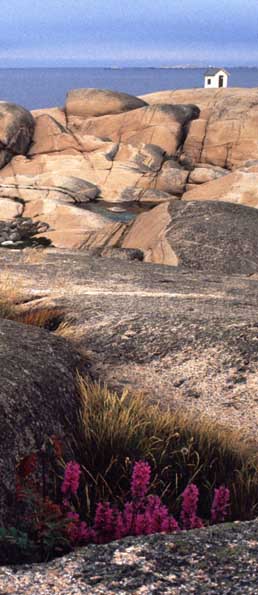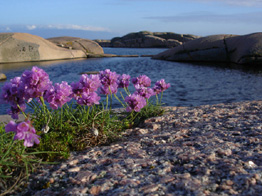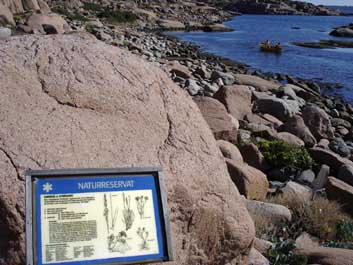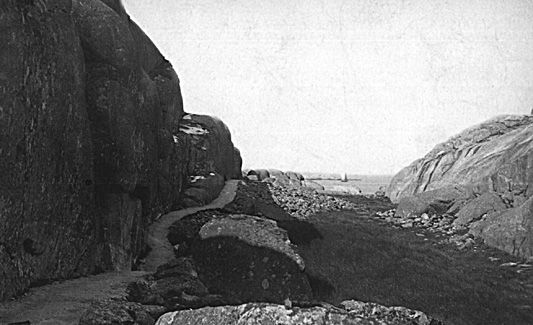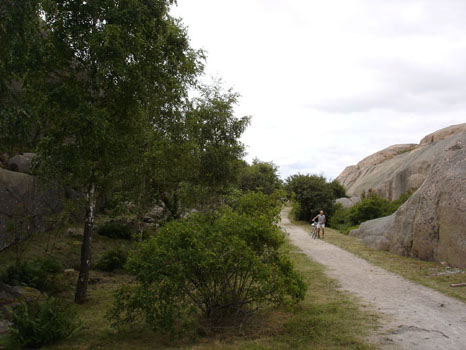Typical for a
beach of boulders is that there is no higher vegetation on its lower part closest to the
water, where environmental conditions are too severe. But a few meters up from the beach a number of species
are present.
One of the more interesting features
inside Kramkistesund is a small population of Lathyrus japonicus, which for many years has grown right next
to the path.
Read
more about Lathyrus japonicus
A characteristic plant on the beach of boulders is Silene uniflora, a fairly low growing
plant with relatively large, white flowers. In a small bay inside
Kramkistan grows a beautiful stand of sea kale, Crambe maritima. Year after year these impressive, meter high plants,
recur. In June they are dotted with white
flowers.
Read more
about Crambe maritima
Besides sea kale, a few species of sea beet grow in the area. Beta vulgaris, spp
maritima, (close relative of Swiss chard - grown as an alternative to
spinach), and also tall beach rye, a robust grass with a long spike in the top.
The boulder beach contains several species and genera that benefit through the increased nutrient supply of seaweeds that
are washed up on the beach. Atriplex littoralis with gray-green leaves and inconspicuous
flowers, and Sonchus arvensis, tall with yellow flowers, are examples of
nutrient favoured species.
In the upper part of the block above the beach on Kramkistesund are bushes of
Rosa rugosa. The species is not originally native to Sweden,
but invaded the west coast during the second half of the 1900s. It
is thought to have spread from East Asia to Denmark in cargoes, and then probably spread
by way of water to
the coast of Bohuslän. Plant location in the upper part of the block beach is typical here,
where the waves reach their maximum at high sea level.
In the hillside in damp crevices
above Kramkistesund the loosestrife, Lythrum salicaria, blooms during late
summer with its orchide-like reddish-purple
inflorescences . The species is also seen in many other places in humid, swamp-like
parts of
Stångehuvud (see photo above).
Among the boulders not too near
the beach, where the soil does not dry out too much, wild Angelica,
Angelica silvestris, grows. This species has a typical flattened inflorescence, unlike the
"sister species" Angelica archangelica, on which it is
rounded. A.
archangelica is usually found in a few places in the beach area at Kramkistesund.
In rock crevices from Kramkistesund towards the area below the lighthouse, one can find the leaves of the
maritime plant species that blooms earliest in spring, scurvy grass, Cochlearia
officinalis, with its small sweet-scented white flowers and clear green rounded
leaves.
Read
more about scurvy grass
Outcrop alternate with moisture spots
Up in the mountains of the Stångehuvud area
outcrop alternates with moisture spots. The dominant grasses are wavy hair-grass,
Deschampsia flexuosa, and Agrostis vinealis. In more humid
areas purple moor-grass, Molinia caerulea, grows along with Juncus conglomeratus, and sedge,
for example Carex nigra. The exposed location forms the bushes and windswept small trees found only in protected areas as
in Storklyftan inside the Cave of the Winds, Vindarnas grotta, (see map).
The beautiful area by the lighthouse
south of Little Munkevik is rich in ponds and areas of moisture. On the left side below the railing leading up to the lighthouse is an elongated
area with marsh and vegetation adapted to moisture conditions. In mid-May
water clover, Menyanthes trifoliata, blooms in hundreds, with its beautiful white and pink flowers. In the midst of summer, the
richness of different species is great. In the moisture of mosses (Sphagnum-species) dwarf cornel,
Cornus suecica, is seen, a species that later in the summer shines
with brilliant red fruits. Beautiful bell heather, Erica tetralix, a western
(maritime) species that can not tolerate too cold winters, also thrives in this moist, nutrient-poor and acidic environment. In
the height of the summer the pink flowers contrast beautifully with the green mosses.
Looking more closely among Sphagnum mosses you can find sundew, Drosera
rotundifolia, an insect-catching plant with reddish, sticky leaves. The secretion which is excreted
causes small insects to stick to the leaves and enzymes found in the secretions deplete the insect. The plant can in this way, ''add to''
the diet in the nutrient-poor environment with nutritional supplements from
insects.
A green valley between Pinnevik and Munkevik
The rift valley between Pinnevik and Munkevik is called
Munkeviks Mule (highlighted in green on the map). A more protected
leeward location combined with deeper soil makes the vegetation here completely different to that of the west side. The windswept, low-growing vegetation towards the sea
is replaced by much more prosperous and taller vegetation. Many of the species can be found in ordinary meadows inland.
Several types of bushes and trees can grow here, including willow, birch and rowan. The wide path which today leads
to Munkevik and Pinnevik was built around 1900, when the stone industry needed better transport routes. Earlier
visitors had to walk on a narrow paved track right on the mountain ridge on the south side of
Munkeviks Mule (see photo below).
In recent years Lysekil - on the initiative of the Carl and Calla Curman Foundation -
has cleared away brushwood, etc. so that
it is possible once again to walk along the old path. The aim is also to keep the valley sufficiently
clear, so that
you can look at the sea in the direction of Munkevik. The flora between Pinnevik and Munkevik is
in some spots influenced by the locally increased lime content of the soil. Near Munkevik,
shells from mussel canning had been dumped in large amounts in the 1940´s..
Potentilla argentea, Trifolium arvense,
hare´s foot, and Sedum album line the path in the middle of
Munkeviks mule. Along a small flat rock just off the trail grows
blackthorn in trellis form. Blackthorn berries ripen weeks earlier than in the free-standing
bushes.
Close to Gullmarsvallen is the only area in Stångehuvud with a real tree stand,
including some species not naturally found wild in Sweden. These trees
were probably planted by schoolchildren in the 1910s and 1920s. Elm, sycamore maple,
large specimens of black pine and a few white spruce are found there.
The granite wall that fences in Gullmarsvallen is an attraction in itself. The blocks in the wall - built
by unemployed stonemasons in the early 1930s - fit perfectly with each
other!
On the granite wall, just above
Pinnevik, is an information board
about Stångehuvud and the Carl and Calla
Curman Foundation.
|
